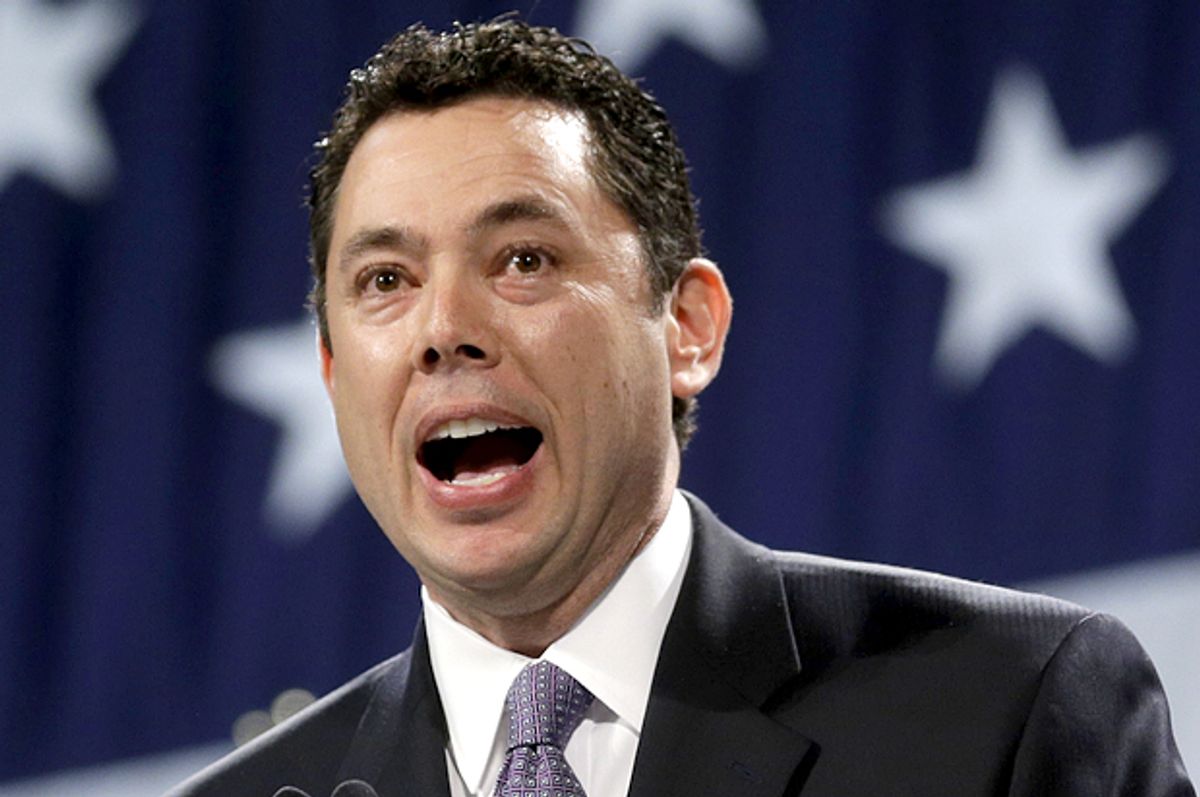The House Oversight Committee’s hearing into recent security lapses by the United States Secret Service played put pretty much how everyone expected it would. Secret Service director Julia Pierson offered unsatisfactory explanations for the agency’s Keystone Kops investigation of a 2011 incident in which several shots were fired at the White House, and the more recent debacle in which a man armed with a knife managed to scale the White House perimeter fence and make it all the way into the executive mansion. The committee members, meanwhile, took the opportunity to vent outrage, browbeat Pierson with diatribes masked as questions, and mug for the television cameras. All this was done in the name of “oversight.”
The competition for who could make the grander spectacle of themselves was stiff. Rep. John Mica held up an ADT sign and suggested that the Secret Service buy some “inexpensive vegetation” to bolster White House security. Rep. Trey Gowdy cranked his volume knob all the way to eleven and then broke it off. But the winner has to be committee-chair-in-waiting Jason Chaffetz, who demanded to know why, when it comes to fence jumpers, the Secret Service doesn’t use “overwhelming force.”
“I want it to be crystal clear. You make a run at the White House, we’re going to take you down,” Chaffetz said. “I want overwhelming force. Would you disagree with me?” The day before, Chaffetz blamed the Secret Service security failures on the desire to be “politically correct.”
No one disputes that, in the wake of all these incidents, the Secret Service either has to rethink its procedures or recommit itself to ensuring that existing security measures are properly enacted. The problems with Chaffetz’s recommendation for using “overwhelming force,” however, are numerous.
First, the level of physical protection surrounding the executive mansion already screams “overwhelming force.” Anyone who’s been to the White House has likely paused to take note the heavy visible security presence. There are uniformed Secret Service agents everywhere, patrolling on foot or on bicycles and heavily armed. There are usually black armored SUVs stationed in the pedestrian-only promenades. There are guard stations, fences, concrete barriers, anti-vehicle obstacles, checkpoints – the security you can see sends the very clear message that there are places you cannot go.
And then there’s the unseen security presence that everyone knows exists. There are sensors above and below ground to detect intruders, and snipers on the roof. If you’re like me, when you stroll past the White House you can’t shake the discomfiting sensation that someone could be peering at you through a scope and scrutinizing your movements.
All this to say that the Secret Service already does a pretty good job of communicating the fact that they are capable of inflicting physical violence upon you if you get out of line. So if someone jumps over the perimeter fence, chances are they’re either mentally unstable or a very determined assailant and already are not deterred by that threat. And, quite often, the people who do intrude upon the White House grounds are suffering from some sort of mental illness. Omar Gonzalez, the man who made it through the front doors and into the East Room, apparently has post-traumatic stress disorder from his time in the military.
If “overwhelming force” is the go-to response, you run the risk killing or injuring people who, even if they do pose a threat, aren’t necessarily aware of what they’re doing. That’s obviously not in the interest of the person on the receiving end of that policy, and the New York Times’ Matt Apuzzo offered a blunt explanation for why that wouldn’t be in the Secret Service’s best interests either.
[embedtweet id="516991380619816960"]
There are also legal questions to consider. Last October, a woman from Connecticut rammed her car into a White House barrier and then led the police on chase down Pennsylvania Ave. to the Capitol, where she was shot and killed by the Secret Service. The woman, who had been diagnosed with post-partum depression, was unarmed but had struck an agent with her car and rammed a police cruiser. The agents who fired the shots clearly felt they were justified in the use of lethal force, but there was nonetheless an investigation amid questions that the Secret Service and the Capitol Police had violated their own policies for firing their weapons at moving vehicles. That investigation ultimately determined that the officers had not broken the law.
The point is that there are rules for when law enforcement personnel can discharge their weapons, and consequences for not following those rules. Chaffetz’s “overwhelming force” recommendation doesn’t seem to want to take that into account.
Also, the White House, despite being one of the more closely guarded government buildings, is still a place where people go to work and a tourist destination. If the Secret Service starts shooting at people who make a break for the White House, there’s a good chance they’ll hit the guy on the wrong side of the fence, and a greater-than-zero chance that they’ll also hit some poor tourist on the right side of the fence. Or they could hit someone who should be inside the fence, like a White House staffer, or a journalist, or a groundskeeper.
The notion of applying “overwhelming force” to a White House fence jumper has so many potentially disastrous unintended consequences that you have to wonder whether Chaffetz has thought it through, or if he’s just throwing out a panicked knee-jerk reaction to an unprecedented security breach. Either way, it’s a dumb idea. The Secret Service has a lot of work to do to make sure White House security remains tight, but there’s no reason to turn the North Lawn into the O.K. Corral.

Shares